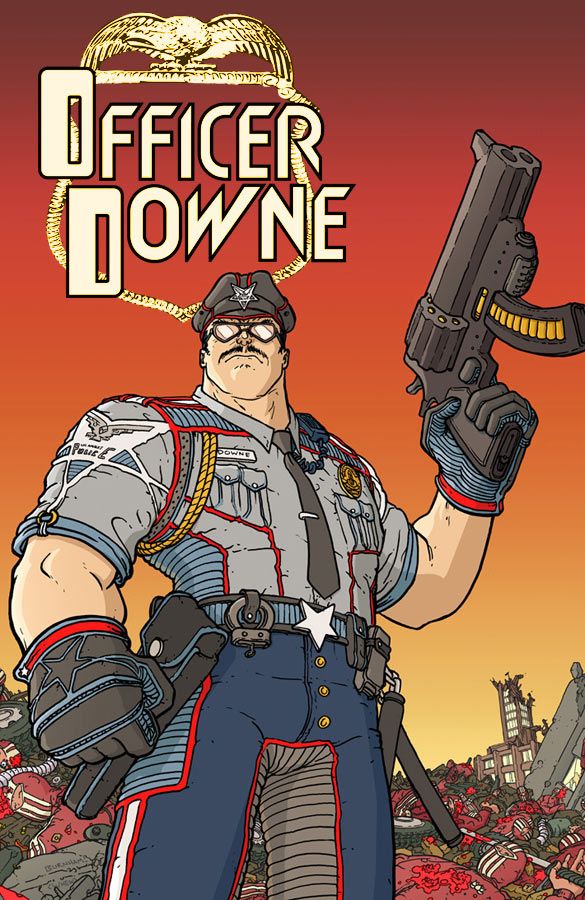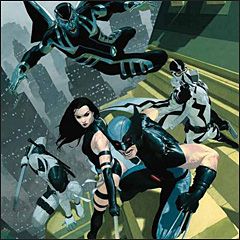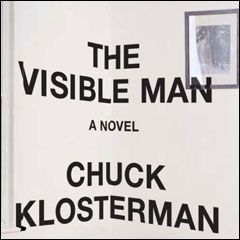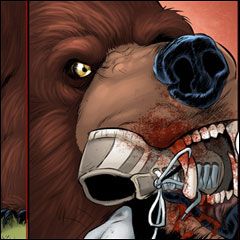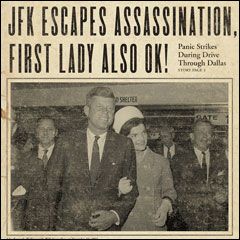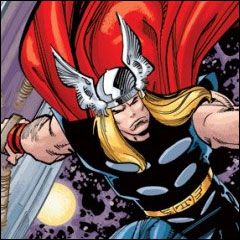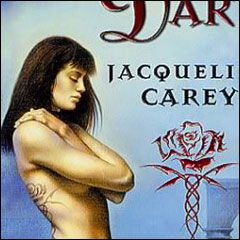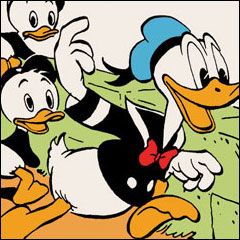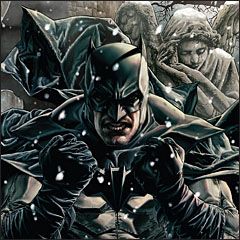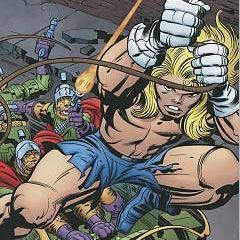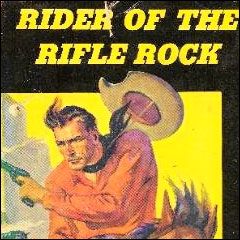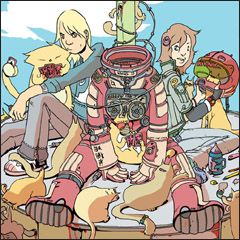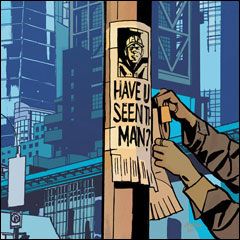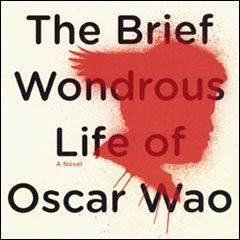Hello and welcome to a special birthday bash edition of our weekly “What Are You Reading” feature. Typically the Robot 6 crew talks about what books we’ve read recently, but since it's our anniversary, we thought we'd invite all our friends and colleagues from Comic Book Resources and Comics Should Be Good! to join in the fun.
To see what everyone has been reading, click below …
*****
Timothy Callahan
Uncanny X-Force #1-19, by Rick Remender, Jerome Opena, Dean White, and others. I've been reading -- and enjoying -- this series since the first issue debuted, but I carved out a couple of hours recently to reread the entire run to see the whole Archangel saga play out as a single story. I wondered if this was, perhaps, the defining run for the character -- the way the Brubaker/Fraction Immortal Iron Fist defined Danny Rand, or the way Jason Aaron provided the definitive Ghost Rider. And upon rereading, I have to say "yes." This first year-and-a-half of Uncanny X-Force is the definitive Angel/Archangel story, and what's so great about it is that Remender built upon the mythology of the character's past instead of trying to revert him to some oversimplified version of the original Lee/Kirby creation. Also, this series is just packed with characters and plot points and yet maintains a deep emotional core. Good stuff, all around.
The Sound and the Fury, by William Faulkner. I'm only about 50 pages into this novel so far, and though I've read a decent amount of Faulkner -- and plenty of Fitzgerald and Hemingway, the other two Big American Moderns -- I've never taken the time to read this acclaimed masterpiece. I'll reserve complete judgment on it until I've finished it, of course, but I already know that it lacks a direct through-line like you'd find in my favorite Faulkner book, As I Lay Dying. When I used to teach that novel, we would explore Faulkner's use of heteroglossia -- basically, the multiplicity of narrative voices -- and he's clearly up to the same tricks in The Sound and the Fury. My prejudice against this novel, and the reason why I've avoided it for so long, is that I assume it will be more of a portrait of a time and a place than an actual, compelling story. I have always been more of a story guy than a portrait guy, personally, but we will see what treasures this novel holds.
Tom Spurgeon's Holiday Interview series. Every year, during the Christmas season, Tom treats us to daily interviews with some of the most interesting people in and around the comic book industry. From Kim Thompson to Jeff Parker to Tucker Stone, we get a profile of the current state of comics from all angles, and the interviews go far deeper than the standard online promotional pieces. These are actual conversations with people who have things to say. Every one of them is worth reading, even if you don't think you're interested in the topic at first.
Timothy Callahan writes CBR's When Words Collide column. He also writes about comics for Tor.com and has his own blog.
Chad Nevett
1. A bunch of Joe Casey comics. Anyone who knows me probably isn't surprised by that statement, but, look at December: Doc Bizarre, the Officer Downe hardcover, new issues of Haunt and Gødland, and the conclusion to Vengeance. All that was missing was a little Butcher Baker... Any month with that much Joe Casey is going to seem a little crazy. Doc Bizarre is some madcap fun, Officer Downe manages to be even more fucked up, and Vengeance ends on such a crazy high note that I think I need to send Mr. Casey a big thank you letter for writing a comic book series so squarely aimed at yours truly. I know I'm not the only one who marked out at Z making a cameo appearance at the end...! I'm still not entirely sure about Haunt (aside from loving Nathan Fox's art). Casey obviously has some plans, but it's hard to see where they're heading. I dug the new issue, though. Ending the year with that small stack of December Joe Casey comics is pretty nice.
2. The Visible Man by Chuck Klosterman. Probably the last book I'll finish in 2011 (I finished reading it late Friday night) and it was a big leap from his first novel Downtown Owl. I've really enjoyed Klosterman's non-fiction (or semi-fiction, maybe?) work for years. Funny, insightful, and always interesting in his essays on pop culture in all its forms. I tend to blow through his books, because they're so damn enjoyable. His fiction, on the other hand, hasn't always grabbed me. Downtown Owl was entertaining and had its moments, but it was definitely something that I read because I like Klosterman's writing. The Visible Man has me thinking that Klosterman may have some strong fiction chops. It's a novel framed as a non-fictional account of a therapist and her (failed) treatment of a man who wears a suit that renders him virtually impossible to see by reflecting light in such a way that you see what's on the other side of him. The protagonist 'Y____' reminds me a lot of a character who has stepped out of a Paul Auster book. Forceful and strange with a strong and unique perspective on the world and himself. Some of the ideas discussed are wonderful. The stories he tells of observing people in their homes without detection are rather engaging -- to the point where the novel suffers a little when it moves away from those stories. The ending is what it is... it doesn't live up to the potential the book or Y____ showed, but... entertaining book that made me stop and think from time to time. And has me wondering what Klosterman's next novel will be like.
3. Banner by Brian Azzarello and Richard Corben, and Filthy Rich by Brian Azzarello and Victor Santos. A couple of Azzarello books that I've been meaning to get for a while. I read Banner years ago on Marvel's website and it's both very like and very unlike Azzarello's other writing. The language games are there in spots, but his dialogue is very sparse -- he really steps back and lets Corben run the show to a degree. Filthy Rich had its moments, but is so rooted in being 'pulp' that it doesn't do much more than work within the confines of the genre. It's a fun little exercise. Santos's art is wildly inconsistent -- but, when he's on, he does a mean Frank Miller impression.
Chad Nevett talks about comics in several different places around the web — at his personal blog GraphiContent, at Comics Should Be Good! and as a reviewer for Comic Book Resources. He also writes about wrestling for 411mania.
Bill Reed
These days I've found myself reading more and more webcomics, and as someone who still hasn't figured out how an RSS feed works, that involves me remembering to read a strip on a specific schedule, and then clicking or typing myself over to the designated webspace from which the particular comic springs forth. I would totally pay real dollars for the following:
Al'Rashad, from Christopher Bird and Davinder Brar, which goes up weekly at Mightygodking, a clever, funny, and superbly drawn fantasy adventure comic that features pirate action, bizarre bazaars and the wiliest mop-haired street orphan since Flim-Flam from The 13 Ghosts of Scooby-Doo.
Bearmageddon, artist Ethan Nicolle's other, non-Axe-Cop webcomic, which has been slowly building its way to the titular Grizzly apocalypse, and has just recently leaped into the Kodiak carnage we've been waiting for, with well-meaning hippies versus nature's hungry killing machines. Nicolle's gorgeous cartooning and Noah Maas and company's vibrant colors give the series the most beautiful mayhem since, well, Axe Cop.
Bucko, by Jeff Parker and Erika Moen, a freewheeling (actually, fixed-gear) epic for our times, populated by hipsters, cyclists, Juggalos, and fartmongers, the strip turns Portland into a magical, madcap fantasy land filled with delightful, deranged characters, the true Oz of the Northwest. Moen's lines have been getting sparer and more confident, the art style becoming more refined, like the evolution of a newspaper comic strip, only at hyperspeed.
Lady Sabre & the Pirates of the Ineffable Aether by Greg Rucka and Rick Burchett, a beautifully realized space pirate cowboy adventure serial that opens with a tremendous swordfight on a space zeppelin before segueing into Sam Elliot kicking ass. I shouldn't have to say any more, but I will: it's the best artwork of Burchett's career, and the included script with each new installment provides a great insight into the collaborative process, specifically in terms of how artwork interprets and diverges from the narrative skeleton.
Bill Reed contributes regularly to Comics Should Be Good! and has his own personal blog.
Ryan K Lindsay
11.22.63: I’m a massive Stephen King fan. Always have been and always will be. Most of his recent fare hasn’t been anything compared to his late 70’s stuff (but what is?) though his short stories continue to thrill and I enjoyed Under The Dome right up until the cop out ending. I am, however, thoroughly enjoying 11.22.63.
There might not be any subtext to this book but you must cast that aside and revel in the fact King is one of the premiere storytellers when it comes to sinking you right into the narrative. There are some King tics that’ll stand out (constantly naming songs to set the tone and you’ll hear his unmistakable voice coming through some of these characters) but the swell of this tale is captivating. King turns a phrase well but mostly he just wants to tell an enjoyable tale and he really is.
There has been more than one occasion in this book where I have stopped because the events have floored me. That’s the sign of a good book to be read. Oh, and this is my first novel read on the iPad and I’m completely digging the way it goes. I have no issue with it at all.
The Cape: This is the sort of comic that makes me excessively proud to be a comic fan. Just by tangentially knowing this product through purchasing, reading, enjoying and reviewing this book, my life is better and I’ve spread the love out into the world. This book started with the acorn of an idea from a Joe Hill short story, and now Jason Ciaramella and Zach Howard have grown it into a mighty tree with a canopy of rich ideas and a nasty lead character at the peak.
If you haven’t picked up The Cape then you need to do it. If you have any member of your family who digs on subversive fare then buy this for them. The level of amazing this comic goes to will win you over completely. Comics need to try this hard more often.
Simonson’s Everything: I listened to Walt Simonson on Word Balloon, and it’s put me in a spin. I’ve owned the SIMONSOMNIBUS (The Mighty Thor Omnibus) for half a year and my New Year’s Resolution is to burn through it all. I might even annotate my thoughts. I also found some Simonson Fantastic Four issues on ComiXology for only $1.99 so I snapped those up. And I’ve also pulled down my old Havok & Wolverine: Meltdown issues for another spin through.
I’m a big back issue fan, as a kid I loved coming back from the comic shop (an hour train ride to and back) and spreading all my swag out on the bed and spending the day losing myself in old Marvel U history. It’s now nice to have my pick of them in authentic old school issues, a massive omnibus presentation, and crystal clear on my iPad. We do truly live in the future – here’s to 2012.
Ryan K Lindsay is a reviewer for CBR and a podcaster with Kurtis J Wiebe and Jeremy Holt on The Process, where they talk about comic writing. He is planning to have a very big 2012 in all things comics.
Greg McElhatton
Kushiel's Dart by Jacqueline Carey: I still remember when Kushiel's Dart was published in 2001; I was living in Falls Church and the local Borders had copies of it everywhere. Clocking in around 700 pages, it looked interesting but daunting at the same time. There are nine books in the series now, and I've still never gotten around to reading them. Fortunately for me, my book club picked it as the January 2012 book, which means I finally have an excuse to dive in. I'm still in the early pages and it's slow-moving, but Jacqueline Carey's prose is comfortable and I'm interested in what I've seen so far about this alternate history. Half of the fun is piecing together what's different when it comes to an alternate history, and this one is no exception.
Embassytown by China Mieville: I've put Embassytown temporarily aside so I can finish up Kushiel's Dart, and already I'm dying to get back to China Mieville's latest novel. Mieville's ideas are always wonderfully huge and crazy, and Embassytown is no exception. What starts out as a simple "humans co-existing with aliens on another planet" story has rapidly turned into a mixture of social dynamics and linguistic oddities. Similar to his novel The City & The City (with its two cities that exist side-by-side where the inhabitants have learned to block out the opposite side), it's hard to describe the joy and wonder of Embassytown without giving away a lot of the wonderful surprises, but if you can make it to the point where you first meet the Ambassadors, you'll quickly learn just why Embassytown is in a class of its own. If you've never read a Mieville book before, Embassytown is a great place to start.
Walt Disney's Donald Duck: Lost in the Andes by Carl Barks: I'm a little mortified to admit that Walt Disney's Donald Duck: Lost in the Andes is my first exposure to Carl Barks (after decades of being interested in finally seeing why he's so revered as a comic creator), but it definitely won't be my last. Fantagraphics' first volume of Barks material is a great place to start; a mixture of epic quests, short stories, and gag strips that are all impressively funny and awesome. There's something wonderfully evil about a strip where a witch is forcing the Duck nephews to cry so that she can turn their tears into a potion to destroy all Christmas trees, only to turn around and have a hilarious transformation sequence to break up the gloom and make you laugh.
A friend once said, "Everything good in the DuckTales cartoon was first done by Carl Barks" and I can see that now. This is one of those rare comics that really is meant for all ages, or for that matter all interests; the only reason it took me a few weeks to finish the book is that halfway through, my non-comics-reading boyfriend started flipping through it and then temporarily claimed it as his own so that he could finish it first. Trust me when I say, that's high praise indeed.
Greg McElhatton writes reviews for Comic Book Resources and Read About Comics, and he has a cool personal blog as well.
Dave Richards
Beautiful, Naked & Dead and Out There Bad by Josh Stallings: If you're like me, you love a great crime story regardless of whether it's published in four color or prose formats and these two prose novels which I recently discovered were some of the best crime stories I read all year. In Beautiful, Naked, & Dead, Stallings' stellar debut novel, you're introduced to Moses McGuire; an ex-marine, ex-con, and strip club bouncer as he goes on a quest to avenge a friend's murder. In the even better follow up novel, Out There Bad, Stallings sends Moses to Mexico for a confrontation with human traffickers. If you love the work of Ed Brubaker, Jason Aaron and Greg Rucka pick these two books up. You won't regret it.
Batman: Noel by Lee Bermejo: I got this as a Christmas present and read it Christmas eve. I don't think I really need to say a whole lot about Bermejo's art. It's beautiful, breathtaking and speaks for itself for the most part. His renderings of Gotham City and the Joker were especially impressive in this. I believe this is Bermejo's first book as a writer though and he does a pretty great job with it. He tells a fun story that does a nice job working the framework of Dickens' A Christmas Carol into a Batman story. Bermejo also did a great job with characterization, especially Superman who serves as the Ghost of Christmas Present. All in all this was a fun holiday read and might just become a Christmas Eve tradition for me.
Hellboy: House of the Living Dead by Mike Mignola and Richard Corben: House of the Living Dead is a tale that involves Hellboy, a Frankenstein style monster, a werewolf, a vampire and Mexican Lucha Libre style wrestling. That's a pretty awesome recipe, and Mignola and Corben cook it up very well for this original graphic novel. In the story it's 1952, and an alcoholic Hellboy is working as a masked wrestler. Thanks to the machinations of a mysterious foe he has to wrestle a scientist's monstrous creation to save a young girl. The result is a fun, strange, exciting tale with a lot of heart.
Dave Richards covers all things Marvel for Comic Book Resources.
Greg Hatcher
Well. I'm sort of reading all three of these at the same time, alternating.
1. The new Kamandi omnibus, because it arrived recently and Kamandi is awesome. I could go on and on but Alex Cox really said it all here a couple of years back...
2. The Green Hornet Casefiles. I love the Moonstone prose anthologies and already own a bunch of them-- the Avenger, the Phantom, Kolchak, the Domino Lady. But I think the ones featuring the Green Hornet may be my favorites and this is the new one. Full disclosure-- editor Win Eckert and I occasionally correspond and he asked permission to use a quote of mine for a cover blurb on the deluxe edition. But I went out and spent my own money on this because I enjoyed the first one so much. New, original prose adventures featuring the Green Hornet and Kato-- and it's clearly MY Hornet and Kato, the Van Williams and Bruce Lee version from the mid-sixties. What with Kevin Smith and Matt Wagner and Seth Rogen and God knows who else doing versions of the Hornet these days, it can get confusing. But this version's mine. Rocking it old-school.
3. For Christmas my wife Julie found me Bennett Foster's Rider of the Rifle Rock, a vintage Western hardcover from 1939. It's a great story of how young Chet Minor learns how to be a real man again after a riding accident that leaves him crippled. I love old westerns and I'm a sucker for a redemption story. This actually is pretty easy to find--reprinted in hardcover under the "Sagebrush Western" imprint not to long ago--but mine's the original one. Because my wife is even more awesome than Kamandi.
You can read more from Greg Hatcher every Friday at Comics Should Be Good!
Pól Rua
Infinite Kung-Fu by Kagan McLeod (Top Shelf Publishing): First, read that again... Infinite. Kung. Fu. Roll it around inside your head for a bit. Give it a bit of reverb. Now try saying it out loud, feeling each syllable thunder off your lips. That's some serious righteousness right there, and a comic book would have to be pretty damn good to live up to a name like that. So, it's damn lucky that Kagan McLeod has the chops (and the kicks, stomps and strikes) to do just that and exceed it.
First of all, he's good. Crazy good. He has a kinetic, graphitti-inspired art style that leaps, glides and dives across the stage like righteous combat lightning. But, in conjunction with that, he's also a hell of a storyteller. He effortlessly translates the classic style of 1970's Hong Kong Kung Fu cinema into comic form, using an incredible degree of craft, draftsmanship and skill to convey all the style, dynamism and impact of martial arts combat into pictures which seem to come alive on the page. And what's more, he knows his stuff, combining bone-shattering kung fu, Taoist mysticism, bloodthirsty zombies, ruthless villainy and funky blaxploitation-fuelled grooves seamlessly together without the disparate elements clashing with each other. In short, this is an amazingly good comic, and Top Shelf have really put it all together into a gorgeous package.
Moriarty and the Hound of the D'urbevilles by Kim Newman (Titan Books): Kim Newman is one of my favourite writers. He's an incredibly literate pop culture critic and commentator and an astoundingly skilled storyteller. He uses similar techniques to Phillip Jose Farmer (in his Wold Newton stories) and Alan Moore (in The League of Extraordinary Gentlemen) in a way that's playful, frequently funny as hell and always utterly captivating.
In this collection of short stories, we are introduced to Professor James Moriarty, a genius obsessed with the "mathematics of crime," who has made his life's work the imposition of pure reason onto the chaotic realm of criminal endeavor. Our point-of-view on this extraordinary criminal is Colonel Sebastian Moran, big game hunter, ex-soldier and rapacious scoundrel, as a kind of anti-Watson. Like many of his other stories, most notably the Anno Dracula series (an alternate world in which Count Dracula became ruler of the world in the late 19th Century) and the Diogenes Club (about an organization of paranormal investigators stretching from Victorian London to
Thatcher's Britain), Newman liberally sprinkles his stories with obscure and not-so-obscure references to various historical and literary character. These don't impede the storytelling--each story is an engaging and entertaining work of fiction in its own right--but they provide an additional layer of entertainment, where the stories can also be read as a fascinating literary game.
King City by Brandon Graham (Image Comics): If there is any justice in the world, Brandon Graham is one name you will be hearing a lot of in the upcoming years. He is ridiculously talented, and has an undeniable style and energy. Imagine, if you can, a story that combines the freewheeling whimsy and character-driven
storytelling of Bryan Lee O'Malley's Scott Pilgrim with the streetwise neo-futurism of Ellis and Robertson's Transmetropolitan or Paul Pope's Heavy Liquid or THB, and you have the world of King City. It's a world of costumed spy gangs and giant atomic monsters, alien pornography and Sasquatch inn-keepers, but it's more than that...
It's a world where our hero, arriving back in town after a long stretch, dreads seeing his ex-girlfriend as he re-connects with old friends. It's a world where a young woman worries about her lover, a recently returned war veteran whose only solace for his night terrors is a drug which may be slowly killing him, but it's more than THAT...
It's a comic where the creator throws in puzzles and games even, in one place, a board game all of which are actually parts of the story and serve a plot purpose. This is GREAT comics. Playful comics. Fun Comics. All delivered with a charm, verve, wit and skill that deserves wider attention. The trade paperback collection should be out in February which I'm as excited as all get out about.
Pól Rua is an artist and occasionally contributes to Comics Should Be Good!
Kelly Thompson
Warren Ellis' Secret Avengers run (Secret Avengers #16 - #20): There's still one more issue left in Warren Ellis' wonderful Secret Avengers run, but he has been blowing my mind with these amazing superhero comics. With incredibly smart standalone stories with limited casts that all feel like they tie together even though they don't depend on one another to make sense Ellis has been creating some of the best superhero comics I've read in 2011. It doesn't hurt that he's got a rotating cast of amazing artists helping him bring these stories to life. Reading this short run reminds me how great a wonderful 20-page superhero comic can be. I wish comics could do more of this and I will be decidedly sad to see this run end. I'll be first in line for the trade when released as well - it'll make for a hell of a strong collection.
Hinges by Meredith McClaren: I'm been reading Meredith McClaren (artist for Jen Van Meter's upcoming Hopeless Savages Volume 4) excellent webcomic Hinges for a while now and I am just constantly blown away by her beautiful haunting work. The mastery of craft in her pages - from the well-developed drawing style, to pitch perfect color choice, to even her stylized execution of word balloons - is just phenomenal. The story of Hinges is frequently text free, relying on McClaren's strong artistic chops to tell the story - but even without words it's emotional and haunting. McClaren is a major new talent in comics and I simply can't wait to see what she does next.
Buffy The Vampire Slayer: Season 9 by Andrew Chambliss and Georges Jeanty: The first arc of Buffy The Vampire Slayer's new series has wrapped and I have to say, I'm pretty enchanted with it. The end of Season 8 had me frustrated and confused, but as always with Joss Whedon, he's managed to bring things back around to a place where I'm re-engaged and highly intrigued by where he wants to take these characters that I adore. The comics have been a funny animal, since they're able to do things and go places that the television show never could and because of that they have different boundaries and rules, but somehow, thanks to great creators and a strong guiding hand from Whedon, the characters, which are the important part in all of this, remain as fascinating and as emotionally engaging as ever. Steve Morris' stunning covers aren't hurting the series any either!
Kelly Thompson writes (and podcasts) for Comics Should Be Good! and reviews comics for CBR. You can also read more from her on her personal site.
Brian Cronin
This week saw the release of two noteworthy Vertigo issues, one an ending and one a beginning.
The final issue of DMZ gave a powerful conclusion to Brian Wood and Riccardo Burchielli's excellent series. Wood chose to use the "leap forward a bunch of years" approach to a finale, which I am always a fan of. I especially enjoyed how Wood decided to give the focus of the final issue to New York City itself...it was a very satisfying goodbye to the book. Much like the tributes within the comic, the subtly of the farewell worked beautifully.
As we say goodbye to the DMZ, we say hello to yet another fascinating new character in Scott Snyder and Rafael Albuquerque's American Vampire. One of the most impressive aspects of Snyder's work in this series has been his ability to quickly develop compelling new characters. This was on fine display in the start of the new American Vampire storyline, where Snyder gave a brilliant take on the 1950's greaser hood archetype.
Brian Cronin runs our sister blog, Comics Should Be Good! and was part of The Great Curve team way back in the day, before we were ever Robot 6. He’s also the author of Was Superman a Spy?: And Other Comic Book Legends Revealed.
Sonia Harris
The Brief Wondrous Life of Oscar Wao by Junot Diáz: I initially picked this paperback up because I liked the cover art and the grainy texture of the coating they had used on it. Then when I flipped it open, the quote on the first page is "Of what import are brief, nameless lives... to Galactus??", which is from the Fantastic Four, by Stan Lee and Jack Kirby in 1966. How could I resist? Inside the book chronicles the life of an unattractive geeky boy and his oddly endearing family life. I'm half way through and so far I'm loving the constant references to comic books which I know and love. It gives me another way to understand the environment the author is describing and I am more involved than I might otherwise be. The book is heavily peppered with long footnotes, explaining all of the cultural and historical references the author makes, which gives the book a conversationally tangential air. So far the author has mentioned Gilbert Hernandez' Love & Rockets characters enough that I am basically imagining this as another "Palomar" story, not so much as a visual reference but as a way to understand the mood and feel behind Diáz' immigrant story.
JLA Vol. 3, Deluxe Edition by Grant Morrison, Howard Porter and John Dell: Along with Vol 4, this was a thoughtful holiday gift I received after I read the first two volumes of Morrison's groundbreaking JLA run and wrote about them in my column. It is lucky I received this, since I don't know if I would have bought the book myself as I felt like I'd just read a ton of this run and didn't want to risk spoiling it. Of course once I started reading I was extremely happy about it. The groundwork Morrison initially laid, now builds to great effect. He continues to develop and elaborate on the storylines of the team and individual characters to the point where I found myself actually wanting to read the crossover stories that were referenced (and I usually hate crossover stories.) In amongst his complex and gloriously random storylines, there is a basic humanity to the character's conversations which is terrifically endearing, it works to anchor and ground the fantastic stories. As it began, it continues, with Morrison giving everyone their own voice and distinctly relatable character. Now I've still got volume 4 to read next and I'm excited to get to it.
Sonia Harris writes her column--Committed--every Wednesday on Comics Should Be Good!


